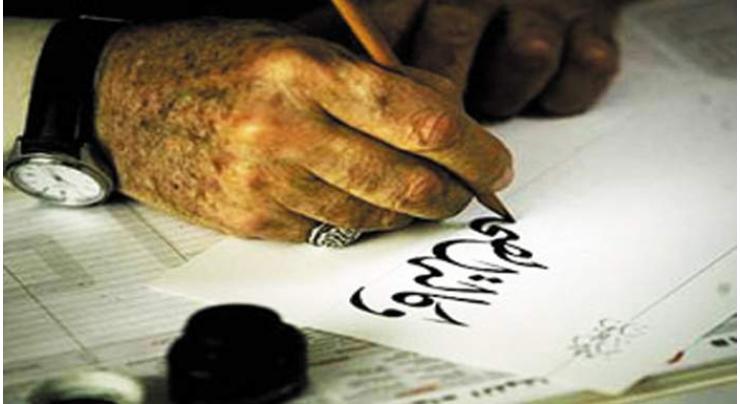
Dying Usage Of Art Of 'Chronogram' In Urdu Literature Rejuvenated At NAPA
Umer Jamshaid Published May 13, 2023 | 09:57 PM

The Urdu literature's history has never been deliberated in such a intense way as it was discussed, here, at the National Academy of Performing Arts (NAPA) on Saturday
KARACHI, (UrduPoint / Pakistan Point News - 13th May, 2023 ) :The urdu literature's history has never been deliberated in such a intense way as it was discussed, here, at the National academy of Performing Arts (NAPA) on Saturday.
The session 'Urdu Hai Mera Naam' was moderated by Romeena Kizilbash Kurieshy, who is an Urdu Pedagogy specialist at New York University.
She was joined in by emerging Urdu scholar, poet and lecturer Jauhar Abbas who shed light on the evolution of the art of 'Chronogram,' which is a specialized art that can extract the exact date and year the poet intended to portray by just reading the Urdu couplet.
However, not every poet is aware to use the art of chronogram in their respective poetry.
To relive the memories and their technicalities, the session was organized to recall the poets who used this particular art and its related delicacies in executing this art in their form of respective poetry.
To elaborate further, Chronogram, which is viewed as a sentence in which specific letters, interpreted as numerals, stand for a particular date when rearranged. The word if loosely translated is 'time writing', derives from the Greek words chronos and gramma.
This had been the normal set of practice for the classical poets to arrange their couplets in such a way that it reflects the year and date.
For instance, one of the finest elegy poet Mirza Dabeer, while paying tribute to his other famous contemporary Mir Anees, said a couplet which when calculated transpired that Dabeer actually arranged it in such a pattern that it coincided with the Anis's year of demise. For instance he said: Aasman Be Mah-i-Kamil Sidrah Be Ruhul Amin Toor-i-Sina Be Kalimullah Mimbar Be Anees The experts believe that the said couplet was arranged in a way which when calculated produced a number that is 1291.
The same number if counted in terms of the Islamic Calendar would reveal that then the Islamic year was 1291 Hijri, 1874 AD.
Anees breathed his last on 10th December 1874.
For the aforementioned reason, this session was a breath of fresh air which conversed a rare topic and tried to rejuvenate it to register its importance.
Jauhar Abbas who has been voraciously involved in studying various poets of the contemporary era and of the past was critical that this particular art was seemingly fading away and in shambles.
In his respective address, Jauhar was wary about the students' lack of interest in deeply studying the evolution of Urdu literature and how this language had transformed with the passage of centuries.
Meanwhile, the topic was designed to highlight the value of the art of Chronogram in Urdu literature, Jauhar who did his thesis during his Masters's (2021) on the technical study of Hafeez Hoshyarpuri's chronograms cited his memories with the poet late Naseer Turabi, to whom he credited for pushing him to delve more into this domain of Urdu literature.
In a PowerPoint presentation, Jauhar discussed Mirza Ghalib, Momin Khan Momin's poetry and gave his insights about how these two iconic figures designed their respective poetry while mastering the art of chronogram.
He urged the participants, who belonged from various walks of life, especially the students of Urdu literature and modern poets, to spare time to read Urdu literature and equip themselves with the latest socio-economic knowledge to take a grasp of the essence art of chronogram to express a well and a meaningful couplet which would eventually travel beyond centuries to come.
The session was followed by a Questions-and-Answers where the audience tried to resolve their confusion about the finest use of the art of chronogram as the experts responded by giving a comprehensive and well-articulated reply.
Recent Stories

Over 37% Tobacco tax increase suggested to save lives, boost revenue

Mohsin Naqvi has offered a substantial incentive, pledging $100,000 to every pla ..

Citizens join Al Barsha Police in “An Hour for Dubai” Initiative

Art can be a powerful tool to relieve stress, Experts say at Sharjah Children’ ..

Currency Rate In Pakistan - Dollar, Euro, Pound, Riyal Rates On 5 May 2024

Today Gold Rate in Pakistan 05 May 2024

Bugti assures transporters for addressing their problems

Deputy Prime Minister and Foreign Minister, Mohammad Ishaq Dar meets foreign min ..

3 drug peddlers arrested, hashish recovered

1496,990 children given polio drops in five days: DC

Six terrorists killed, hideout busted in N Waziristan IBO: ISPR

Pakistan, Qatar agree to further expand trade, investment ties
More Stories From Pakistan
-
Bilawal felicitates Naila Kiani
30 minutes ago -
Bilawal felicitates newly elected ANP President Aimal Wali
30 minutes ago -
Water flows gradually rise at Kotri barrage
40 minutes ago -
Hockey team performance reflects selection on merit; Rana Mashhood
50 minutes ago -
SSP visits Sweet Home
50 minutes ago -
CDA hosts successful Taekwondo competition for students
50 minutes ago
-
DPO holds open court
1 hour ago -
Man killed in brawl
1 hour ago -
KP people still await change: Azma Bukhari
1 hour ago -
LESCO collects over Rs 3.25m from 53 defaulters in 24 hours
1 hour ago -
Awami Sculpture Garden to be set up at Nasser Bagh
1 hour ago -
Oghi police apprehend step-mother's killer within 24 hours
1 hour ago